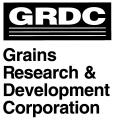RSS
Olivia travelled to Central (Guatemala) and North America (Mexico, Florida and Hawaii) to obtain knowledge and skills in mass-rearing techniques and quality management of parasitoid wasp production
TRAVEL DETAILS
REYNOLDSO
When: June 2009
Location: Central and North America
Summary:
Olivia Reynolds travelled to Central and North America to obtain knowledge and skills in mass-rearing techniques and quality management of parasitoid wasp production.
LOCATION
This project was an extension of an earlier scoping project CRC30014 that developed software to collect surveillance data via small personal digital assistants (PDA) devices.
The software developed enhances the conformity and integrity of data collected during urban surveillance activities.
There were two central aims of the second phase project. The first was the delivery of the urban surveillance software to a greater number of surveillance personnel as well as mapping the best method for the integration of collected data into national initiatives such as The Australian Biosecurity Intelligence Network (ABIN) and Biosecurity Surveillance Incident Response and Tracing (BioSIRT).
The second aim of the project was to provide the post-harvest grains industry with a system to digitally collect and collate all grains pests surveillance information (presence/absence of emergency plant pests (EPPs), resistance to phosphine and fumigation/treatment records).
The project introduced a system that provides for seamless digital collection and collation of all surveillance related biosecurity information for the post-harvest grains industry. The system has built in checks to ensure data integrity and it is proposed that collected data may also directly interface with BioSIRT. This means it has the capacity to easily interface with other compliant (national and other) systems and also provides a development path into the future, which could include initiatives like ABIN.
This project allows the rapid and efficient use of all surveillance data to maintain and protect markets for the Australian grains and potentially other agricultural/horticultural industries.
Research outcomes:
PDA Phase Two project successfully developed and deployed six main applications:
- Biosecurity hazard site surveillance
- Multi-pest surveillance (MPS, BioSIRT compatible)
- Khapra beetle surveillance
- Forest plantation pest surveys (IPMG)
- MyPestGuide mobile pest datasheets
- Urban plant pest surveillance (USDB)
- Dermestid surveillance
- Stored grain ecology studies
- European wasp surveillance
- Exotic dung beetle surveys
- Locust surveys
- Tramp ant surveys
The Urban Surveillance Database was built with generic plant biosecurity surveillance in mind and has been adapted for a number of diverse projects. It services the popular need for recording property and contact details, one-is-to-many geo-located and barcoded activities (including digital image), one-is-to-many inspections of activities, one-is-to-many specimen details can be added with barcoded specimen labels and photograph.
Field-collected data are synchronised (two-way data transfer) from anywhere in the world via GPRS, WiFi to a wireless server hosted at DAFWA where it is available for further analysis and reporting.
Smartphone pest identification tools have become popular and can be used in conjunction with USDB to ensure rapid field recognition of potential Emergency Plant Pests. This project developed two database-driven smartphone apps (MyPestGuide & PestWeb Mobile). Individual pest records are added on the wireless server and pushed out to devices. These smartphone identification tools can be deployed as a shell for overseas users, or pre-populated with quarantine pests of significance.
Collaboration with CRC for Forestry resulted in development of the mobile software solution, called IPMG Plantation Health. This software allows foresters to quickly and accurately record pest and disease outbreaks in the field, including; the date of the observation, the extent and severity of any damage caused, GPS co-ordinates and photos. The software also includes brief weed and pest field guides to aid foresters with correct identification in the field.
Research implications:
A high proportion of Australia’s agricultural produce is exported and demonstration of freedom from certain plant pests and diseases is critical to maintaining and securing new market access opportunities. Pest surveillance is an important tool for market access and accordingly importing countries now demand accurate, credible evidence to confirm pest freedom status.
In the past nearly all field-collected plant biosecurity surveillance information was recorded manually to paper reducing the rate of capture, integrity, conformity as well as security of the data. There is a growing need for plant pest surveillance data collection software and hardware that uses smartphones to provide auditing validation, ‘chain of evidence’ as well as increasing the volume of data collected and its integrity through relational databases and seamless data transfer to corporate systems. Smartphone data integrity is supported by GPS-located traps, digital voice navigation itineraries, time and date stamps, field printed barcode labels, site and pest imagery.
Pest identification tools delivered via smartphones are an important tool that allows immediate identification of potential biosecurity threats in the field.
Acknowledgements:
The following CRCNPB participants provided constructive criticism during development of the applications; Michelle Chami, David Cousins, Oonagh Byrne, Marc Widmer, Richard Johnston, Mike Grimm, Peter Gillespie, Deborah Kent, Cain Roberts, Paul Pheloung, Greg Hood, Steve Pratt and Deb Riddell.
Brian McCornack (KSU), Gordon Gordh (USDA) provided a useful US perspective.
Francisco Tovar (CRC Forestry/ Murdoch University) designed the IPMG application. Peter Davis demonstrated the potential for USDB in ant surveys on Barrow Island.
PROJECT LEADER

Assoc Prof Giles Hardy
Project Leader CRC70085: Personal Digital Assistants (phase two)
g.hardy@murdoch.edu.au
Phone: 08 9360 6272
Fax: 08 9360 6303
Read More
PROJECT DETAILS
Complete
Term
July 2009 – April 2012
Budget
$1,371,600 (cash and in-kind support)
PROGRAM DETAILS
LOCATION
Making it Really Simple to stay informed
Everyday there are millions of online authors writing about billions of different topics.
There are increasing international concerns about food quality and safety. Import requirements are becoming more demanding and exporters including Australia now need not only to declare they are free from plant and animal pests and diseases, but they need to demonstrate it too. As a result, pest surveillance has become a critical tool to secure market access. Exporting countries now need to provide accurate, credible data with evidentiary chain to confirm freedom status.
Research outcomes
Technical equipment like Personal Digital Assistants (PDAs) have emerged as a powerful tool not only to collect information but also to improve the quality and application of the data collected. Cooperative Research centre for National Plant Biosecurity (CRCNPB) PDA software developed with Visual CE was successfully tested during the 2007 post-border detection of Khapra beetle in suburban Western Australia by providing evidence of complete eradication via 1,273 trap inspections. This achievement was supported by GPS-located traps, digital voice navigation itineraries, digital time and date stamps, field printed barcode labels, site imagery, Google Maps integration all in a single hand-held unit.
New PDA hardware and software continues to be developed by the CRCNPB for use in other pest surveillance activities. These include hazard site pest surveillance, stored grain fumigation monitoring, grain insect resistance testing and fruit fly phenology studies.
Research implications
Australia remains committed to World Trade Organization agreements, sanitary and phytosanitary agreements, the International Plant Protection Convention and international sanitary and phytosanitary measures. We recognises the need for quarantine plant pest surveillance data of the utmost integrity is essential to support area freedom negotiations.
With most of Australia’s agriculture produce exported, securing and maintaining market access is critical as is the need to demonstrate freedom from certain plant and animal pests and diseases. Surveillance is an important tool for securing market access and as discussed exporting countries now need to provide accurate, credible evidence to confirm absence (i.e known not to occur) for pest freedom status.
This CRCNPB project focused on the development of pest surveillance data collection software and hardware using hand-held computers or PDAs. This approach provides chain of evidence control, increases the volume of data collected as well as its integrity through relational databases and seamless data transfer to corporate systems.
Acknowledgements
Damian Shepherd, Iain Martin, John Bruce (Department of Agriculture and Food Western Australia (DAFWA) Spatial Information Systems) and Bob Vassallo (DAFWA Animal Biosecurity) provided technical input. Department of Fisheries and Forestry Surveillance Reference Group participants collaborated with beta testing the Urban Surveillance application; Peter Gillespie, Deborah Kent, Craig Murdoch, Tony Monteith, Rebecca Yarrow, Bruce Baker, Wayne Marshall, Russell Elliott, Megan Szczerbanik, Nita Ramsden, James Swan, Heather Wallace, Richard Johnston, Cain Roberts, Melanie Hay, Jo Slattery, Sharyn Taylor, Stephen Dibley, Paul Pheloung, Gareth Men, Greg Hood, Debra Riddell, Peter Frecklington. Shirani Poogoda (DAFWA) beta tested the Fruit Fly Phenology application. Ern Kostas (CBH Group) beta tested the Grain Fumigation application. Peter Davis (DAFWA) beta tested with ant surveys on Christmas and Norfolk Islands.
PROJECT LEADER

Mr Robert Emery
Project Leader CRC30014: PDA-Assisted Surveillance (phase one)
remery@agric.wa.gov.au
Phone: 08 9368 3247
Fax: 08 9368 3223
Read More
PROJECT DETAILS
Complete
Term
September 2006 – August 2009
Budget
$436,800 (cash and in-kind support)
PROGRAM DETAILS
LOCATION
This project will improve the level of preparedness for, and the sustainable resistance to, the Russian wheat aphid. it will also assist Australia's grain industry to remain free of Russian wheat aphids.
What is the biosecurity problem?
Russian wheat aphid has invaded all major wheat growing regions of the world except Australia. To ensure that Australia's breeding strategy has the capacity to provide resistant wheat lines, it is necessary to understand the mechanisms underlying virulence.
The main output of this project is to:
- improve level of preparedness for Russian wheat aphid incursions into Australia, and
- develop a strategy for Australian wheat breeders to achieve sustainable and stable resistance to Russian wheat aphid, reducing the need for insecticides.
Who will be the end-users of this research?
The project will determine what level of risk is posed by genetic changes in the Russian wheat aphid. Results will be discussed with the Australian grains industry. The focus with industry will be to help create an understanding of the risk posed by the Russian wheat aphid, particularly in relation to their breeding program. This will benefit the wheat industry's level of preparedness and ensure that its principal strategy of resistant varieties remains viable.
PROJECT LEADER

Dr Owain Edwards
Project Leader CRC40006: Russian Wheat Aphid
Owain.Edwards@csiro.au
Phone: 08 9333 6401
Fax: 08 9333 6646
Read More
PROJECT DETAILS
Active
Term
August 2006 - September 2012
Budget
$373,800 (cash and in-kind support)












